Hot rods can be handcrafted works of art or an old jalopy with used parts from whatever source the builder had available. Big money isn’t always necessary. The common ingredient is ingenuity. A perfect example would be this 1930 Ford Model A coupe for sale on craigslist in Mesa, Arizona. While it looks like a run-of-the-mill homebuilt Model A, it is what’s under the hood that reflects a rodder’s thrifty ingenuity: a four-cylinder Mercruiser boat engine! With an asking price of $24,000, do you think this nautical powerplant hot rod is priced on the money or has the seller gone overboard?
Before accepting this assignment, I never knew that re-using boat engines was a thing. I found this monster thread on the H.A.M.B. going into great detail on the use of these engines. The deal is that most of these were Chevrolet four-cylinder engines that were modified for marine use. Builders love these tough little engines because they are plentiful, cheap because the boat usually rotted before the engine died, and parts are easy to find. The drawbacks are a change in camshaft is required and that many of these blocks rusted out internally because whatever body of water they were in was used as coolant.
While I don’t think we will see any Ridler Award-winning hot rods powered by Mercruiser engines any time soon, using one of these engines in a Model A Ford makes a bit of sense. Those not shackled by a desire for originality would look at one of these engines and see that the dimensions are in the same ballpark as a Model A four banger. From there, the internals are beefier in the Mercruiser and they produce significantly more horsepower and torque. Adapters are available and, as in the case of this Model A, motor mounts can be fabricated.
Speaking of this Model A, it doesn’t appear that the builder was going for the high-dollar look. Everything other than the seemingly rust-free Model A body and boxed frame appears to have come from a salvage yard. No billet aluminum or Summit catalog bling here. The seat covers appear to be a blanket from Stuckey’s, the steering column and steering wheel are new to the car, and the door panels just aren’t there anymore. The only thing from a catalog is the shifter for a GM Turbo 350 automatic transmission.
Under the hood, we see the previously mentioned Mercruiser 4-cylinder engine. We can also see a GM-style alternator, a transmission cooler, and what appears to be a one-barrel carburetor. The seller also tells us that the car has F100 hydraulic brakes in place of the stock mechanical setup and the rear end is a Ford 9″. No other bells and whistles are evident. Not even a wolf whistle.
What this car really represents is a return to hot rodding’s roots. You made do with what you had or could scrounge, always looking for the next improvement. Sadly, most hot rod projects we see today either end up as half-finished projects in someone’s backyard or an overdone rolling catalog for the hot rod mail order supply house of your choice. While I think it may be tough sledding for the seller to get what they are asking for, finishing this car would be a good project for someone. Seeing budget build hot rods like this one on the road and at shows may be something the hobby needs.
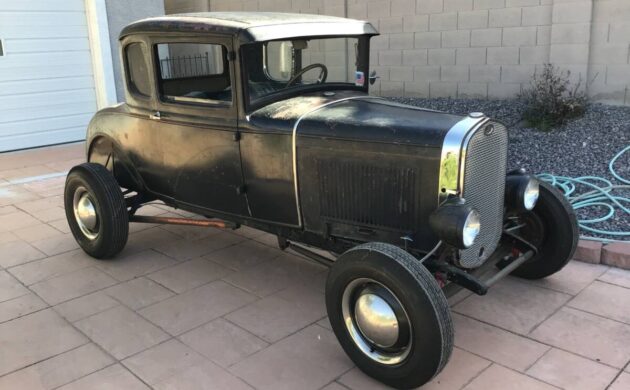
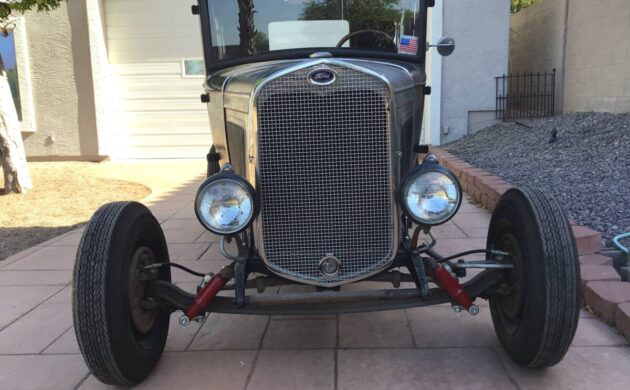
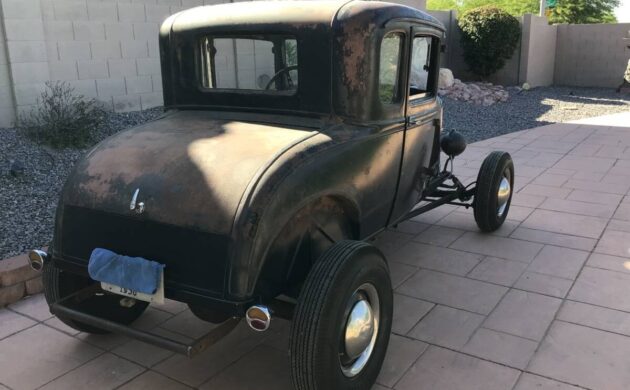
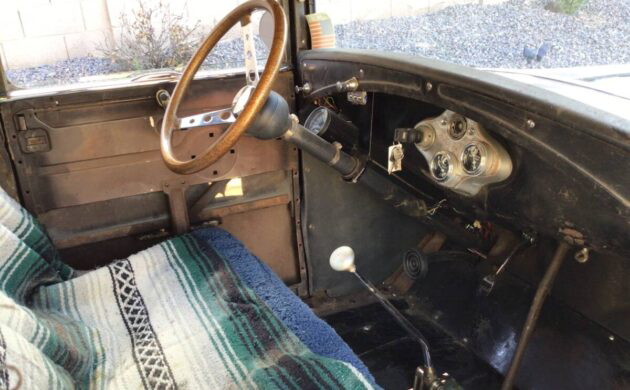
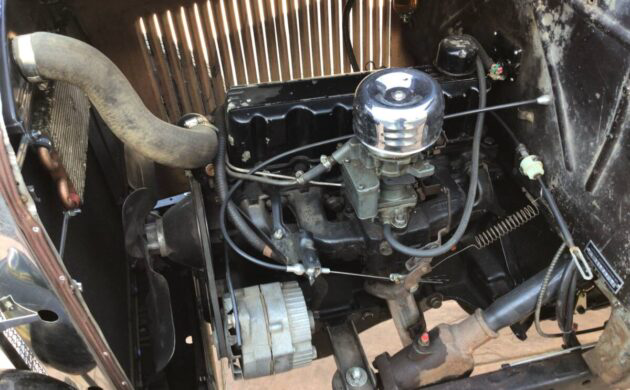


Good mechanical skills with boat engine into a car but….priced way too high.
No problem with the engine, just the price for a car that looks half finished. Put fenders and an interior on it then you’ve got my vote…with a reduction in price.
Should be able to adjust the price to sell it – if they are a boativated seller, that is…
Well, let’s call a spade a spade, the motor is more GM than Mercury. It’s the 181 ci, I think an offshoot of the 153, 4 banger. I read Mercury bored and stroked the motor, originally for industrial use, but I believe made its way into Chevy lls and Chevelles. I think postal Jeeps used them too. Anyone?
My old man had an inboard/outboard with this motor. IDK, it was nothing to write home about. It was a welcome change from the 2 stroke monsters of the day. If I recall, it had a voracious appetite for fuel. I think the builder had a boat laying around, and copped the motor. It’s a cool ride none the less.
The only thing Mercruiser about that motor is the paint. None of those parts are marine, except maybe the block and valve cover, maybe water pump. Classic Chevy II motor here.
It’s not a Mercury at all Howard it’s a MerCruiser. They used Ford and Chevy blocks.
I guess that the seller thinks that the COVID craziness that has hit used cars also applies to hot rods. Mercury engine is a nice touch, but definitely doesn’t require a Ford 9 inch for the amount of torque that it makes.
Chevy Iron Duke.
Not an “Iron Duke.”
https://en.wikipedia.org/wiki/Chevrolet_153_4-cylinder_engine
See the section regarding the Vortec 3000
Still there’s tons of Pontiac Iron Duke DNA in this marine engine. Pontiac grabbed the engine from Brazil and modified it for use in passenger cars for the 1977 model year.
Three strikes and it’s out.
1) overpriced
2) boat motor in a car? Nope….
3) bastardized. Keep a Ford a Ford, and a Chevy a Chevy.
There are some vehicles I wouldn’t be caught dead in, but this isn’t one of them. I’d be ok being caught dead in this one.
Would be acceptable to me if there was a third pedal – when I was a kid, nobody wanted an automatic, that’s what your mom’s car had.
This thing is an excercise in futility.
For another 4 grand or so you can have a complete original Model A in the driveway. Price is way too high.
The cam from a marine engine should be OK. It’s when you start putting airplane engines in cars that you run into problems.
Way way way overpriced. And ugly.
Most all boat engines started out as car engines. My boat has a GM 502 BBC it was in trucks long before it went into a boat and I am sure the reverse procedure wouldn’t take much.
yep, I am a Toyota Landcruiser fan, and while reading thru many forum posts came across a guy who swapped a Mercruiser 454 into a 62 series wagon.
I like the car. I might even warm up to the engine. But, auto trans? Bronco 9-inch? And, the price? And, missing so much, like fenders, bumpers, etc. YUK.
As previously mentioned and well said, only thing here is the Mercruiser Phantom Black paint. Mercruiser did fool around with their own 4 cylinder engines with the 470 line, which I believe was their own block design, and a cylinder head from someone’s v8. This is what I was hoping to see in here. Those motors were oddballs but relatively powerful. And they had a whole set of their own idiosyncrasies.
Right now on eBay there are original Model A’s going for way less the this abomination. Hard pass on this overpriced scrapyard reject!
Engine choice is a great idea if you just want a nice cruiser, not a tire smoker. A few years ago I was planning on putting an S10 5 speed in a mostly stock 30 Model A pickup, gaining overdrive and synchromesh. An adapter kit is available for around $1000. I started thinking about going with a Chevy II 4 cylinder. Has the Chevy bell housing pattern and all clutch parts are off the shelf. I picked up an industrial engine out of a Massey Harris swather. A friend gave me a boat with the inboard Mercruiser. Between the two engines I should have all the brackets etc that I need. Will still have to figure an open drive line, but should be able to make it a lot more drivable with no cutting and 90% of the people won’t know it’s not a stock Model A.
Also keep in mind fenderless cars are illegal in most states for use on public highways
The history of these 4 cylinders is so cool. My buddy’s neighbor has race cars with those Chevy 4 bangers. The marine side adds more history and it’s neat to see kit bashing to “get er done” with what you have. Not everything needs an LS or SBC to be fun…
It’s got the old school hot rod look that I remember as a kid growing up in the 50s. So I like that about it. I’m in agreement with those who would prefer a manual transmission. I also think it’s way too much money for what you would be getting. $24K can buy me a wide variety of way more desirable (for me) cars. That said given today’s insane market; it wouldn’t surprise me to see it sell at or near the asking price.
Per Wikipedia. GM produced a variant of the 153 for use in industrial and marine applications, with the Brazilian version’s larger 4-inch (101.6 mm) bore and a longer 3.6-inch (91.4 mm) stroke. The resulting 3.0 L (181 cu in) engine, branded the Vortec 3000, was never installed in passenger cars. The Vortec 3000 is manufactured in Mexico where 1992-to-present engines have a one-piece rear seal similar to the one used with the Chevrolet small-block and 90-degree V6 (the flywheel bolt pattern for the later-production 3-liter does not interchange with the earlier 153 or 181 which uses the small-block and inline-six’s 3.58-inch bolt-circle, and does not use the 1986-present one-piece rear-seal flywheels since the bolt pattern is larger).